By: Bart Gazzola
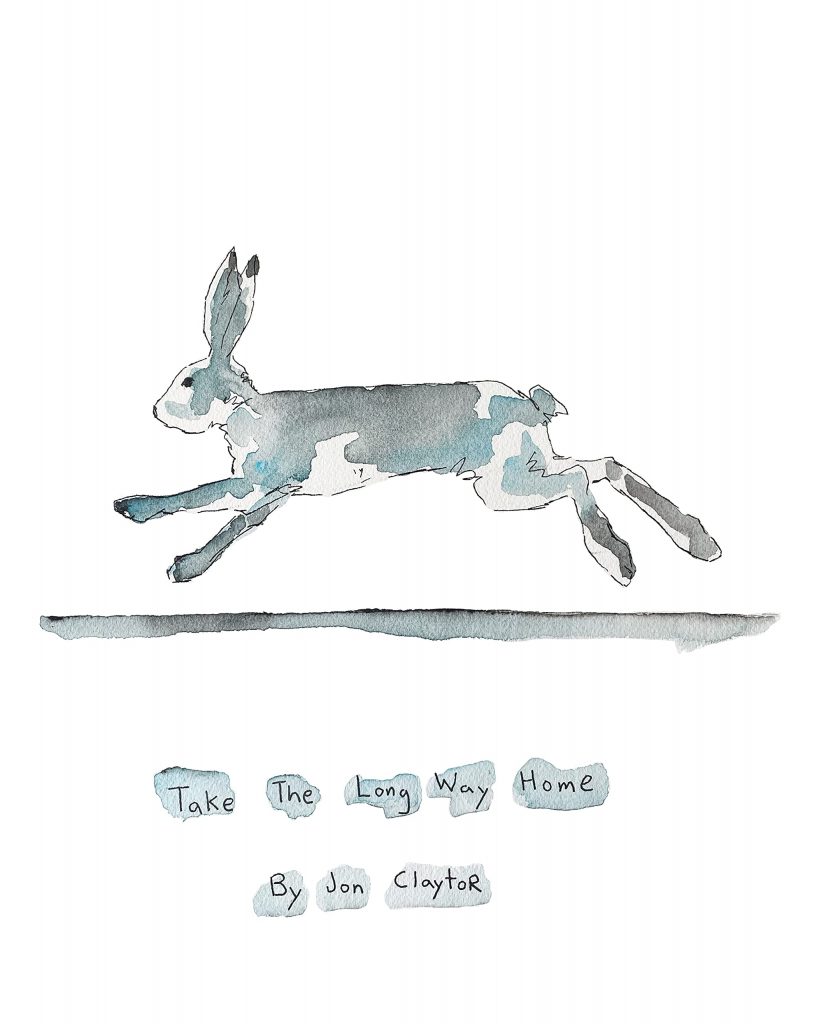
Take The Long Way Home | Jon Claytor
July 25, 2022High culture has pretty much disappeared along with the dress code.
Read More
A – MAZE – ING LAUGHTER, 2009 | YUE MINJUN
July 28, 2022A – Maze – ing Laughter, 2009 | Yue Minjun 岳敏君
A bronze sculpture located in Morton Park in Vancouver, British Columbia, Canada.
I NEVER knew anyone so keenly alive to a joke as the king was. He seemed to live only for joking. To tell a good story of the joke kind, and to tell it well, was the surest road to his favor. Thus it happened that his seven ministers were all noted for their accomplishments as jokers. They all took after the king, too, in being large, corpulent, oily men, as well as inimitable jokers.
(Edgar Allan Poe, Hop-Frog; Or, the Eight Chained Ourang-Outangs, 1849)
Art in the public sphere is often interesting: the intended meaning of the artist may be subsumed by the larger interpellation of the work by the publics or communities that interact with the artwork on a daily basis, or over extended periods of time. You don’t even need to consider the larger argument about monuments that proffer ideologies that were once celebrated and are now suspect (to say the least): Yue Minjun’s installation in Morton Park, in Vancouver, B.C., can’t help but have an unsettling quality, and critical analysis of his work has used the phrase ‘cynical realism’ repeatedly, though the artist seems somewhat neutral on that categorization….
Minjun’s larger than life characters are surely laughing at us, not with us – and their number, their intimidating nature, their grins and smiles that seem ready to eat us up, brought to mind Edgar Allan Poe’s dark story Hop – Frog (specifically the king and his ministers, with their ‘jocular’ abuses of those weaker than they) which I quoted at the beginning of this curator’s pick.
I do favour literary references when responding to visual arts, but this one is particularly apt. The synopsis of the story: The title character, a person with dwarfism taken from his homeland, becomes the jester of a king particularly fond of practical jokes. Taking revenge on the king and his cabinet for the king’s striking of his friend and fellow dwarf Trippetta, he dresses the king and his cabinet as orangutans for a masquerade. In front of the king’s guests, Hop-Frog murders them all by setting their costumes on fire before escaping with Trippetta. (from here)
But that description is a bit bloodless: Poe was erudite, especially in terms of more morbid, or caustic, turns of phrase, and his characters reflected this.
Hop Frog’s final declaration, in the story, and his last words before escaping, are these:
“Ah, ha!” said at length the infuriated jester. “Ah, ha! I begin to see who these people are now!” Here, pretending to scrutinize the king more closely, he held the flambeau to the flaxen coat which enveloped him, and which instantly burst into a sheet of vivid flame. In less than half a minute the whole eight ourang-outangs were blazing fiercely, amid the shrieks of the multitude who gazed at them from below, horror-stricken, and without the power to render them the slightest assistance.
At length the flames, suddenly increasing in virulence, forced the jester to climb higher up the chain, to be out of their reach; and, as he made this movement, the crowd again sank, for a brief instant, into silence. The dwarf seized his opportunity, and once more spoke:
“I now see distinctly.” he said, “what manner of people these maskers are. They are a great king and his seven privy-councillors, — a king who does not scruple to strike a defenceless girl and his seven councillors who abet him in the outrage. As for myself, I am simply Hop-Frog, the jester — and this is my last jest.”
Perhaps that scenario that Poe wrote – where those who mock are held to account – is a good one, to keep in mind as you wander the maze of these towering, awing figures that seem to cow us with their dramatic poses. But it would be remiss to not consider a less dour reading, which coincides with what brought these works to my attention – and that is from a recent rewatch I engaged in, focused on the iconic television series The X-Files.
To steal another’s words on this: Maybe the problem is that we’re confusing the mirror for the window and vice-versa. The fact that Mulder and Dr. They are discussing these provocative ideas among the fourteen statues that make up the “A-maze-ing Laughter” exhibit in Vancouver’s Morton Park adds another complicating layer. These bronze behemoths, each in a petrified state of hysterics, were conceived by the Beijing-based artist Yue Minjun as exaggerated self-portraits, and fall under the movement known as Cynical Realism, a response to the Chinese government’s oppressive approaches to aesthetic expression. Yet they’ve paradoxically brought such joy to a populace an ocean away that they’ve been made a permanent fixture of the Vancouver cityscape….Pain in one place begets gaiety in another, and even a calcified smile has the power to counteract, if not necessarily defeat, the despots. (from here)
All images are from Wikipedia Commons.
~ Bart Gazzola
Read More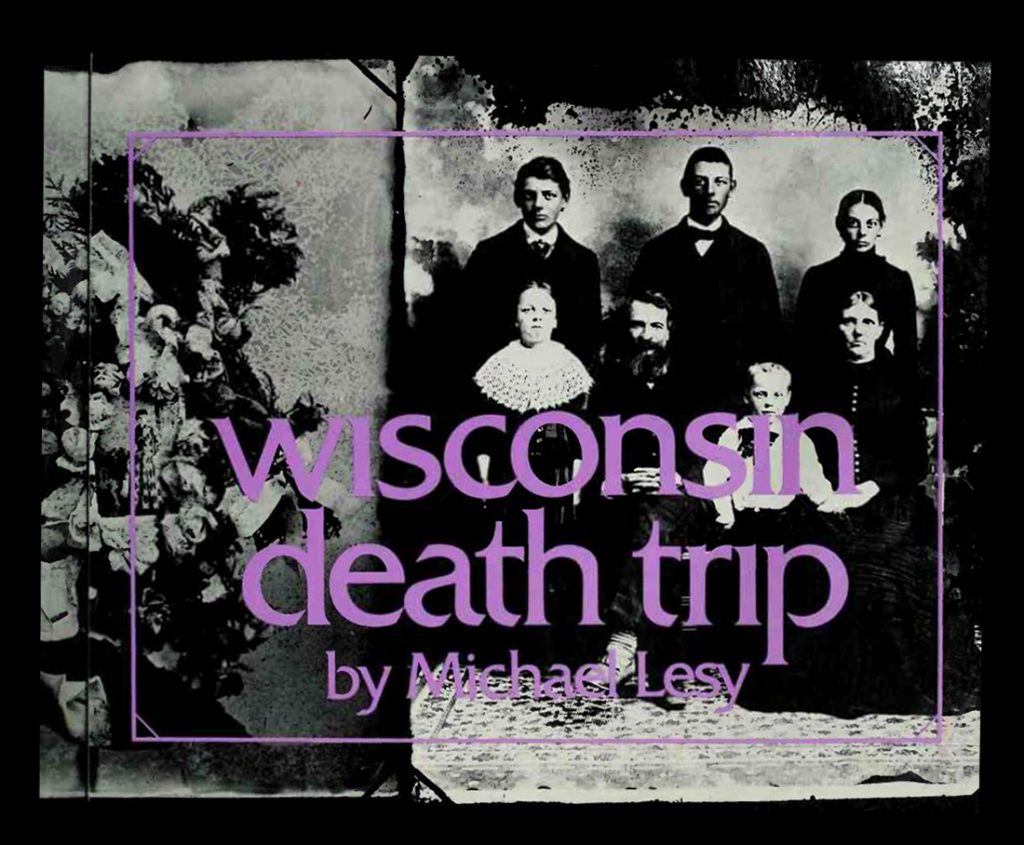
Wisconsin Death Trip | Michael Lesy, 1973
August 11, 2022Wisconsin Death Trip | Michael Lesy, 1973 (reprinted in 1991 by Anchor Books, and University of New Mexico Press in 2000)
Pause now. Draw back from it. There will be time again to experience and remember. For a minute, wait, and then set your mind to consider a different set of circumstances: consider those scholars and social philosophers who never knew that Anna Myinek had burned her employer’s barn or that Ada Arlington had shot her lover, but who nevertheless understood that something strange and extraordinary was happening in the middle of the continent at nearly the same instant that they sat in their studies, surrounded by their books. Such men did their best to understand what it meant, and in the process they tried to predict that future in which we are now enmeshed.
The only problem is how to change a portrait back into a person and how to change a sentence back into an event….The thing to worry about is meanings, not appearances.
I first became aware of Wisconsin Death Trip – the book by Michael Lesy and the James Marsh film it inspired, which I’m less impressed with – while reading Stephen King’s novella 1922, as King has mentioned it as inspiration. It’s one of those King stories that could be interpreted as flirting with the supernatural, but may, in fact, simply be everyday horror. 1922 tells the tale of an ignorant, greedy man on a failing, hardscrabble farm, who murders his wife and thus brings about the death of his beloved son (the ‘ghost’ of his wife returns, Banquo – like, to tell of this before his child’s body is even found). He survives only to suffer and regret, losing all he owned – and his hand, to infection – and is haunted, for years, by the rats that consumed his murdered wife’s body, that only he can hear, and suffers their chittering call and bites in the long dark nights until he takes his own life to escape….
Read more of Gazzola’s thoughts about Wisconsin Death Trip here.
Read More
Philip Monk | Is Toronto Burning?: Three Years in the Making (and Unmaking) of the Toronto Art Community
July 7, 2022Philip Monk, Is Toronto Burning?: Three Years in the Making (and Unmaking) of the Toronto Art Scene, London: Black Dog Publishing, 2016.
Jack Pollock, Dear M: Letters from a Gentleman of Excess, McClelland & Stewart, 1989
“Each day I write. I’m not sure what it’s all about, but most days I write about art and the constant raping of its values by pseudo intellectual acrobats.” (Jack Pollock, Dear M: Letters from a Gentleman of Excess)
Nothing seems more improbable than what people believed when this belief has gone with the wind. (Doris Lessing, The Golden Notebook)
“Culture has replaced brutality as a means of maintaining the status quo.” (Philip Monk, Is Toronto Burning? Three Years in the Making (and Unmaking) of the Toronto Art Scene)
A spate of old issues of FILE magazine came into my hands over the past year (it’s worth noting that they were a gift from Elizabeth Chitty, who also gave me the copy of Monk’s book that spurred this essay). They’re a bit ragged, but that seems appropriate, as they’re like flashbacks (the magazine began publishing in 1972 and ran for 17 years, with 26 issues) that don’t resonate with many, more nostalgia than substance.
They seem very dated, at times very juvenile, and more of an exercise in artistic onanism than anything else. This is, of course, a generalization, and it’s broken in certain points quite clearly. The issue that is almost entirely colour images of the three poodles, one of the many symbolic personas of General Idea, engaged in various tumbling and enthusiastic sex acts is one to keep (as I was impressed when I saw one of the large paintings from this series on a trip to the Art Gallery of Hamilton, installed amidst other notable Canadian works from Graham Coughtry to Attila Lukacs).
But many of the other copies of FILE are easily dismissed, even by someone like myself who has made a career of excavating in spaces that are too often ignored as pertains to Canadian Art history. The odd flash of brilliance, or the appropriation of mainstream media narratives and iconography, the sampling of authors from Burroughs to Acker, are the exception, not the rule.
Perhaps, this many decades later, our expectations of how artists engage in appropriation is more sophisticated – or more jaded. Edit as you will.
But all this reminded me of my long overdue response to Philip Monk’s book Is Toronto Burning? Three Years in the Making (and Unmaking) of the Toronto Art Scene), published several years ago, and that is focused upon the same era. I found the book uneven, and some players and characters in this story seem somewhat incongruous to their later roles or personas (true or assigned, in that vague way of art history and cultural narratives). But Monk’s own words lead to this: “In a sense, what follows is a story, a story with a cast of characters. These characters are pictured in video, photography, and print – not necessarily as portraits but rather as performers.” (from the chapter 1977). But in finally offering my impression of Monk’s narrative (considering personal and public factors and all the sites where those contested narratives collude and collide), I’ll begin with the following assertion: “All narrators are unreliable. Especially when they are characters within their own story.”
Read more here.
Read More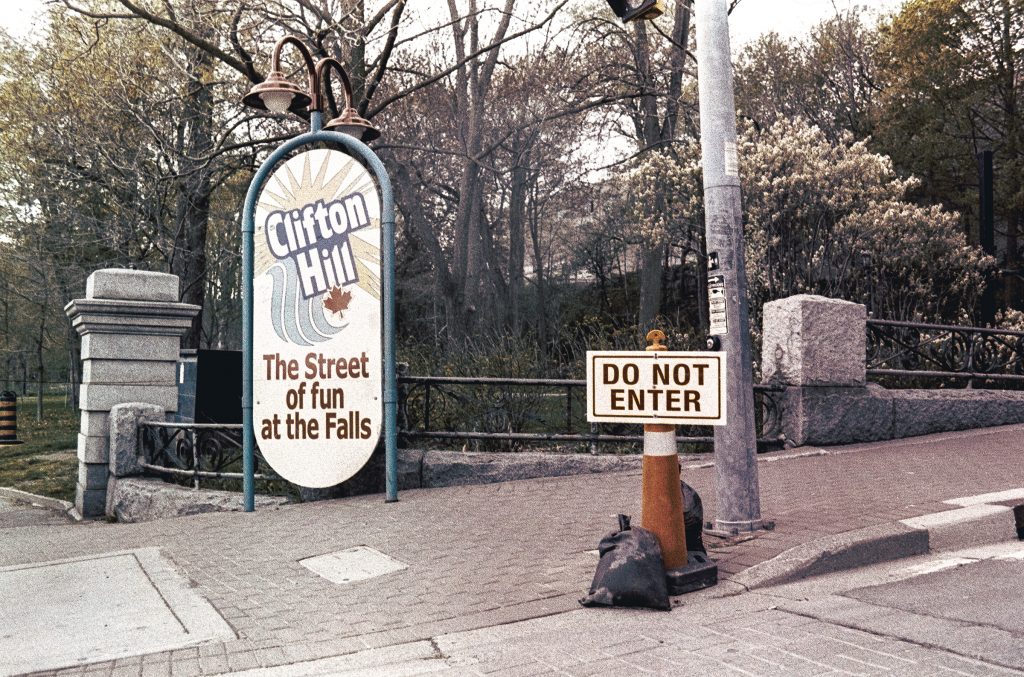
Necropolis | Jon Lepp
May 18, 2022Necropolis | Jon Lepp Necropolis | Jon Lepp, The Open for Business Series @deadendstories Photographs, [Virginia] Woolf claims, "are not an... Read More

The Land of Error | Ioanna Sakellaraki
July 16, 2022The Land of Error | Ioanna Sakellaraki
Ioanna Sakellaraki is best known for her evocatively mournful series The Truth is in the Soil, and it was the work of hers that initially caught my attention. But perusing her site, the more enigmatic and haunted The Land of Error series is the work that keeps pulling me back to it, and inspires me to share it with others.
The only descriptor from the artist for this work is the following bold – and surely intimidating yet also evocative – declaration:
THE FUTURE IS SPLIT BETWEEN MANMADE ANTITHESIS AND PARODIES OF HUMAN PREDICTION. THIS IS WHERE FICTION FINDS ITS JUSTIFIED PLACE.
Sakellraki’s work is often about memory, and an element of mourning. I would inject here that looking at these images, I am reminded of Percy Bysshe Shelley’s poem Ozymandius (1918) : Nothing beside remains. Round the decay / Of that colossal wreck, boundless and bare, The lone and level sands stretch far away. Realizing that poem was written as WWI came to a close, I see correlations between the enigmatic post industrial wastelands that Sakellraki captures, and that earlier era’s destruction and desolation through technology. Quiet scenes of abandonment and detritus…..
Less historical, but equally dark, I’ve begun re watching the science fiction series FRINGE: and Sakellraki’s images also bring to mind the fictional group ZFT, from that show, with story arcs often centred upon world – building – and, of course, world – destroying, too. From that show’s mythology: ZFT in fact stands for “Zerstörung durch Fortschritte der Technologie” which is German for “Destruction by advancement of technology”….
More of Ioanna Sakellaraki’s artwork can be seen here, and more of this series can be enjoyed here.
~ Bart Gazzola
Read More
War Map Dress Trilogy | Carolyn Wren, 2003-2004
June 30, 2022Carolyn Wren | War Map Dress Trilogy, 2003-2004
(lino blocks, hand-printed on Dupont silk, thread, zippers, mannequins, model airplanes, black paint)
I encountered these towering figures during Wren’s retrospective exhibition Task At Hand at the now shuttered Rodman Hall Art Centre several years ago. Standing in the large back gallery space, the three female figures dominated the room, with the flow of their dresses spilling out from them, pooling around them on the gallery floor.
Visiting this show numerous times, I found that different ideas came to the fore with different interactions, from initial wonder to later, more critical consideration. When an artist / writer friend, Anna Szaflarski, visiting Niagara, came with me on one occasion, she saw the works in a very different light than I had, initially. Unsurprising, really, as when Szaflarski and I first met, it was around her exhibition at NAC about the historical detritus – or lack thereof – of General Motors’ legacy in St. Catharines, and I believe we connected over an irreverent honesty about history, the region, and the intersecting if conflicting stories of the place we both grew up in….
My reading had been informed by Wren’s own words, which are as follows: The ingenuity of Christopher Clayton Hutton’s invention of silk maps for the British Royal Air Force during World War II enabled pilots to use lightweight and durable maps to help them reach safety in times of crisis, and inspired women to make dresses out of the silk maps as their men returned home. The maps used by Wren in the dresses were made in Europe by the Canadian government and shipped to Canada for families to follow the movements of their loved ones fighting in the war. Alluding to multiple layers of symbolism of the landscape in relation to the body, and reflecting on war and the politics of Feminism (viewpoint, memory, and identity), The War Map Dress Trilogy is more about history, location, distances, than it is about terrain.
I talk a lot about ‘contested narratives’: but this story, this Curator’s Pick is very much about that. Szaflarski – a former student of Wren’s, as Caroline taught in Niagara for some time, and helped shape a few generations of artists and art appreciators – upon seeing the exhibition, and these ‘women’, spoke more in a manner reminiscent of Barbara Kruger’s famous – and still relevant – artwork that declares that YOUR BODY IS A BATTLEGROUND. These battlefield maps, on dresses hanging on mannequins without heads or hands, look more like spaces to be attacked, or acted upon, utterly passive and just victims…. (“Afterwards she could not walk for a week, her feet would not fit into her shoes, they were too swollen. It was the feet they’d do, for a first offence. They used steel cables, frayed at the ends. After that the hands. They didn’t care what they did to your feet and hands, even if it was permanent. Remember, said Aunt Lydia. For our purposes your feet and your hands are not essential.” Margaret Atwood, A Handmaid’s Tale).
More of Carolyn Wren’s work can be seen here. A recent curatorial project of mine, based upon the Rodman Hall Collection, and which included Wren’s work, can be seen here.
Photographs are by Sandy Fairbairn and the author.
~ Bart Gazzola
Read More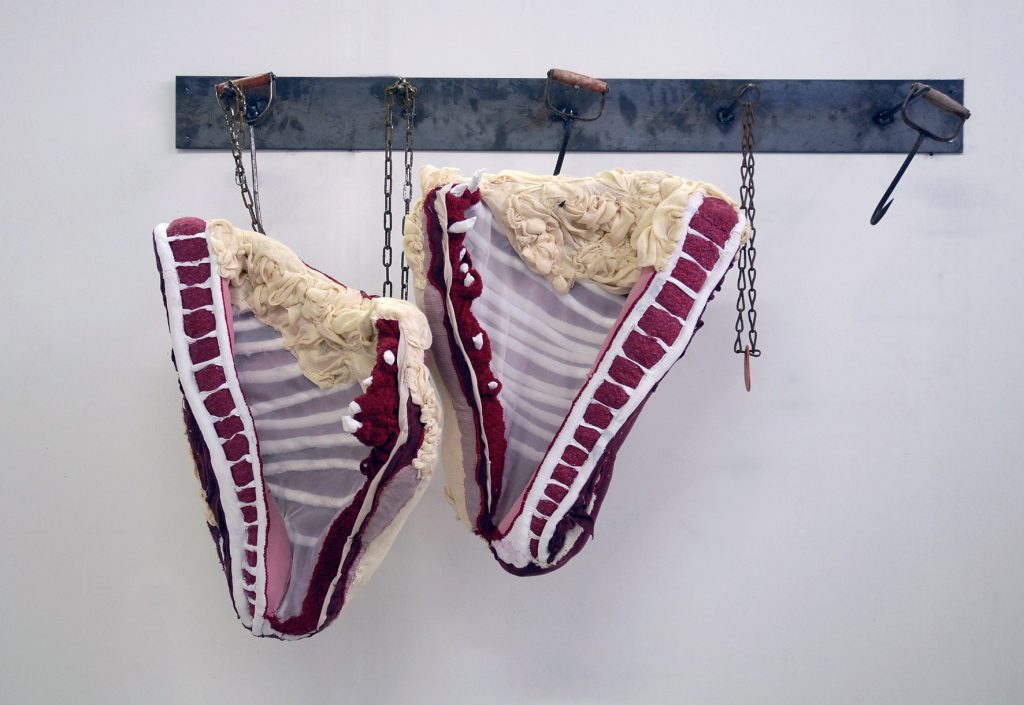
TAMARA KOSTIANOVSKY | ACTUS REUS
June 17, 2022Tamara Kostianovsky | Actus Reus
I am afraid the good woman did not realize how difficult it is to cut up a body, never having done so herself. (Margaret Atwood, Alias Grace)
To the Puritan all things are impure, as somebody says. (D.H. Lawrence, Sketches of Etruscan Places)
Tamara Kostianovsky’s artworks are disquieting; that is meant as praise. What her sculptures in the body of work titled Actus Reus – both specific elements and the larger installations of multiple components – do is allude, and we do the rest. What we initially ‘think’ we’re looking at is not at all what we’re truly observing. An initial revulsion turns to seduction, and we find ourselves drawn in by both the formal attraction as well as the conceptual fracture that only makes her work more enticing.
It’s almost appropriate, then, that one of the works that comprises Actus Reus is titled Abnegation (which means “the act of renouncing or rejecting something”); or that the name of the series itself is a ‘criminal’ legal term. Actus Reus is “sometimes called the external element or the objective element of a crime….the Latin term for the “guilty act” which, when proved beyond a reasonable doubt in combination with the mens rea, “guilty mind”, produces criminal liability in the common law−based criminal law jurisdictions of numerous countries….” There is almost a culpability in our own interactions with these artworks…..
Other works in this series – What It Once Was (2011), One and a Half (2008), Bound (2008), Venus (2011), Elegy (2009) – all leave the viewer feeling as though they’re looking upon – and enjoying gazing upon, devouring with their eyes – something that is forbidden, not meant to be seen, and definitely not be enjoyed, as though illicitly consuming visual pleasure from them….
Before I delve further into my interpretations of Kostianovsky’s work, her statement is as follows: The discovery of a world concealed behind the skin took form in my adolescence while working at a surgeon’s office, where veins exploded into waterfalls, cut ligaments set free the muscles they once contained, and chunks of fat poured over tissues of various colors and textures. A fascination with these encounters put the body at the center of my work, allowing me to use this imagery to reflect on consumption, ecology, and the voracious needs of the body.
Read more of Bart Gazzola’s thoughts on this work here.
Read More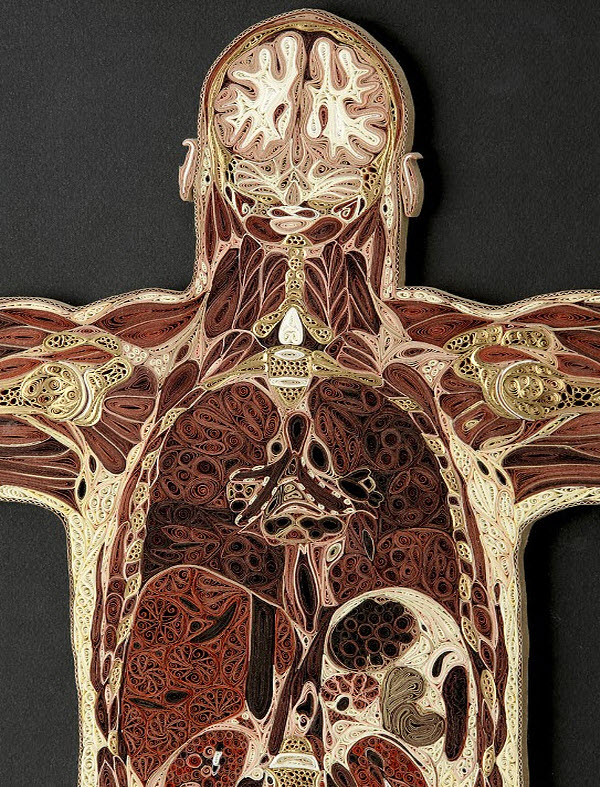
The Tissue Series | Lisa Nilsson
May 7, 2022The Tissue Series | Lisa Nilsson
Everything that has beauty has a body, and is a body;
everything that has being has being in the flesh:
and dreams are only drawn from the bodies that are.
(D. H. Lawrence)
Lisa Nilsson’s works are immediately visceral. But when you learn how they’re assembled, that bodily aesthetic, suggesting a wetness, a moistness, if you will, suddenly becomes dry and almost antiseptic.
This image is from her series of Anatomical Cross-Sections in Paper, and the artist offers the following about them and her process: These pieces are made of Japanese mulberry paper and the gilded edges of old books. They are constructed by a technique of rolling and shaping narrow strips of paper called quilling or paper filigree. Quilling was first practiced by Renaissance nuns and monks who are said to have made artistic use of the gilded edges of worn out bibles, and later by 18th century ladies who made artistic use of lots of free time. I find quilling exquisitely satisfying for rendering the densely squished and lovely internal landscape of the human body in cross section.
It’s interesting to consider the reference to bibles here – a tome that has much to say about the body and it’s ‘regulation’ (I’m old enough to remember the NEA ‘controversy’ when Mapplethorpe and Serrano were demonized by the Republican Helms, and how Lucy Lippard cast that in terms of adversarial religious dogma regarding interpolations of the body. Both artists mentioned here self identify as catholic and the late and unlamented Jesse Helms – their most bilious attacker – was a rabid evangelical). How the body is to be ‘regulated’ is also a fiery topic in the United States, right now….
I’m also reminded of the intersection between science and art, in terms of medical illustration, and an exchange from Katherine Dunn’s excellent novel Geek Love:
“What made you,” clearing my throat, “decide to be an artist?”
Her eyes flick at my feet under frowning brows. “No, no. A medical illustrator. For textbooks and manuals … ” Her tongue sneaks out at a corner of her mouth as she slaps stroke after vicious stroke onto the defenseless page. “See, photographs can be confusing. A drawing can be more specific and informative. It gets pretty red in there. Pretty hot and thick.”
More of Lisa Nilsson’s Tissue Series can be enjoyed here. Her work is meticulous and enthralling – like a bloodless autopsy.
All photographs here are by John Polak. ~ Bart Gazzola
Read More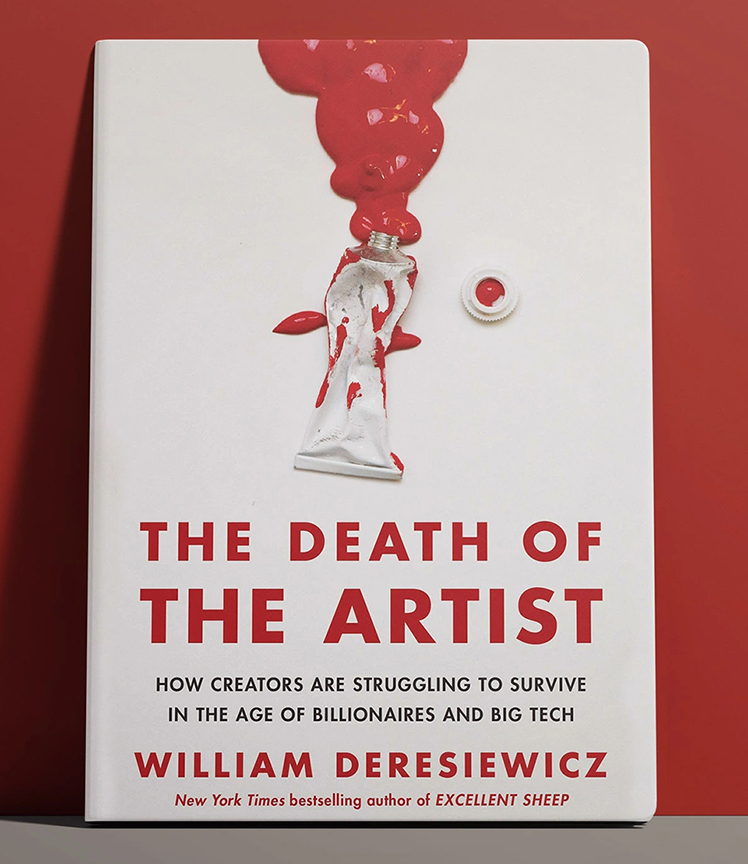
The Death of the Artist | William Deresiewicz, 2020
June 3, 2022The Death of the Artist: How Creators Are Struggling to Survive in the Age of Billionaires and Big Tech | William Deresiewicz, 2020
I cannot think of another field in which people feel guilty about being paid for their work—and even guiltier for wanting to be.
This is – bluntly – a difficult book. It was necessary for me to read it in installments, and I know that many of my friends who are artists had to do the same. Perhaps it was like a series of inoculations against a disease, spaced out to have maximum curative effect. It motivated me to revisit Robert Hughes’ essay Art and Money, from his book Nothing If Not Critical, and simultaneously I was reading Blockchain and the Law: The Rule of Code by Primavera De Filippi and Aaron Wright (as part of my ongoing attempt to understand the phenomenon of NFTs better). Three decades separate those two books, and they make an interesting extended bibliography to The Death of the Artist. Sometimes there’s concurrences, more often disagreement, and a feeling that more time must have passed between their publication, as the gulf is so wide that Doris Lessing’s idea that ‘nothing seems more improbable than what people believed when this belief has gone with the wind’ floated in the air, as I read.
For anyone who’s worked in culture, or has attended art school or various other educational institutions focused upon producing ‘creators’, there are numerous assertions made in William Deresiewicz’ book that will ring true, in a rueful manner that many of us may have denied (or sadly, will continue to do so, unto the pauper’s grave). Some of the stories from the artists – of various stripes – that Deresiewicz spoke with, that inform this book, will be very familiar. My own experience in public galleries or artist run centres, and attempting to negotiate being a cultural worker in other spheres, match the stories here.
This book might offend you, but it will offend you in all the correct ways, and perhaps offend all the appropriate people.
If art is work, then artists are workers. No one likes to hear this. Nonartists don’t, because it shatters their romantic ideas about the creative life. Artists don’t either, as people who have tried to organize them as workers have told me. They also buy into the myths; they also want to think they’re special. To be a worker is to be like everybody else. Yet to accept that art is work—in the specific sense that it deserves remuneration—can be a crucial act of self-empowerment, as well as self-definition.
A tangent, not unrelated, if I may, that aligns with Deresiewicz’ research: a friend is an artist, exhibiting widely, and has been teaching as a sessional for several years. She is me, twenty years ago: she has less protection, security and opportunity than I did, despite both of us doing ‘all the right things.’ We are – like many workers – in a steady decline, that seems not only unstoppable, but unrecognized. Another gem from Deresiewicz’ book: The writer and visual artist Molly Crabapple, another exemplary leftist, puts it like this in her essay “Filthy Lucre”: “Not talking about money is a tool of class war.”
Art is hard. It never just comes to you. The idea of effortless inspiration is another romantic myth. For amateurs, making art may be a form of recreation, but no one, amateur or professional, who has tried to do it with any degree of seriousness is under the illusion that it’s easy. “A writer,” said Thomas Mann, “is someone for whom writing is more difficult than it is for other people.” More difficult, because there is more for you to do, more that you know how to do, and because you hold yourself to higher standards.
If I ever dared to revisit academic or educational spaces – or if I was let back in – this text would be required reading, not just for those wanting to become artists, but especially for those who would go on to be gallerists, cultural workers and even players within the political sphere, as in some ways this book is a warning. But there’s a large dollop of Cassandra in cultural spaces, especially in Canada (several years ago, I was pilloried for shaming an artist run centre for not paying emerging artists, but the abuse was worth it as they – eventually – did the right thing). Deresiewicz’ research, and the testimonials in this book, can help break that complacency….
The Death of the Artist: How Creators Are Struggling to Survive in the Age of Billionaires and Big Tech is not so much a warning, as a reality. It is a severe, but indispensable, book.
All quotes in italics are from Deresiewicz’ book. As usual, I suggest visiting a local bookstore (such as Someday Books) to pick up this text.
~ Bart Gazzola
Read More
Recent Comments